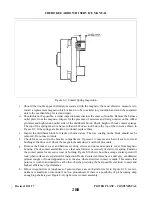
Overboost
An overboost condition means that manifold pressure is exceeding the
limits at which the engine was tested and FAA certified and can be
detrimental to the life and performance of the engine. Overboost can
be caused by malfunctioning controllers or improperly operating
waste gate in the automatic system or by pilot error in a manual
controlled system. Refer to latest copy of Lycoming Service Bulletin
No. 369.
Overshoot
Overshoot is a condition of the automatic controls not having the
ability to respond quickly enough to check the inertia of the
t u r b o c h a rger speed increase with rapid engine throttle advance.
Overshoot differs from overboost in that the high manifold pressure
lasts only for a few seconds. This condition can usually be overcome
by smooth throttle advance. A good method for advancing the throttle
i s a s f o l l o w s . A f t e r a l l o w i n g t h e e n g i n e o i l t o w a r m u p t o
approximately 140° F, advance the throttle to 28” to 30” manifold
pressure, hesitate 1 to 3 seconds and continue advancing to full
throttle slow and easy. This will eliminate any overshoot due to
turbocharger inertia.
Bootstrapping
This is a term used in conjunction with turbo machinery. If you were
to take all the air coming from a turbocharger compressor and duct it
directly back into the turbine of the turbocharger, it would be called a
bootstrap system and if no losses were encountered, it would theo-
retically run continuously. It would also be very unstable because if
for some reason the turbo speed would change, the compressor would
pump more air to drive the turbine faster, etc. A turbocharged engine
above critical altitude (wastegate closed) is similar to the example
mentioned above, except now there is an engine placed between the
compressor discharge and turbine inlet. Slight system changes caused
the exhaust gas to change slightly, which causes the turbine speed to
change slightly, which causes the compressor air to the engine to
change slightly, which in turn again affects the exhaust gas, etc.
Critical Altitude
A turbocharged engine’s wastegate will be in a partially open position
at sea level. As the aircraft is flown to higher altitude (low ambient
pressures) the wastegate closes gradually to maintain the preselected
manifold pressure. At the point where the wastegate reaches its full
closed position, the preselected manifold pressure will start to drop
and this is considered critical altitude.
Added: 5/1/80
2B2
CHEROKEE ARROW III SERVICE MANUAL
POWER PLANT - CONTINENTAL
Summary of Contents for ARROW III
Page 4: ...THIS PAGE INTENTIONALLY LEFT BLANK 1A4...
Page 12: ...THIS PAGE INTENTIONALLY LEFT BLANK 1A12...
Page 94: ...Figure 4 2 Wing Installation Revised 2 13 89 1D22 CHEROKEE ARROW III SERVICE MANUAL STRUCTURES...
Page 171: ...lH3 INTENTIONALLY LEFT BLANK...
Page 172: ...lH4 INTENTIONALLY LEFT BLANK...
Page 286: ...THIS PAGE INTENTIONALLY LEFT BLANK Revised 2 13 89 2A8...
Page 528: ...INTENTIONALLY LEFT BLANK 2K10 THRU 2L24 2K10...
















































